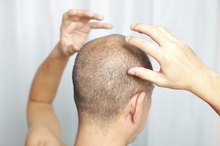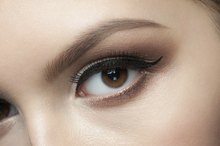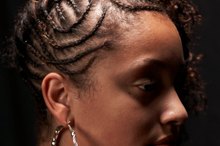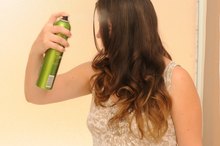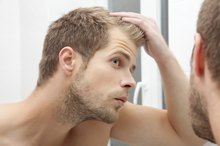What does fact checked mean?
At Healthfully, we strive to deliver objective content that is accurate and up-to-date. Our team periodically reviews articles in order to ensure content quality. The sources cited below consist of evidence from peer-reviewed journals, prominent medical organizations, academic associations, and government data.
The information contained on this site is for informational purposes only, and should not be used as a substitute for the advice of a professional health care provider. Please check with the appropriate physician regarding health questions and concerns. Although we strive to deliver accurate and up-to-date information, no guarantee to that effect is made.
Greasy & Thinning Hair
Excessively oily hair appears thin, straggly and limp.
Add a thinning hair condition on top of it, and you might wonder whether any hope remains for your hair. Fortunately, most cases of greasy and thinning hair can be controlled and made to look better through a combination of cosmetic procedures and hair-loss medications.
Appearance
Hair commonly thins with age. Women especially experience a gradual, overall thinning associated with age and genetic-related hair loss.
Men also thin as they age, but the pattern is more pronounced.
They start losing hair at the hairline and crown of the head, resulting in a receding hairline and thinning crown. Eventually, many men go completely bald on top.
Women, however, rarely go completely bald or experience receding. Greasy hair appears wet and oily. The hair lies close to the scalp and lies in stringy, separated strands rather than in full, fluffy masses.
- Hair commonly thins with age.
- Women especially experience a gradual, overall thinning associated with age and genetic-related hair loss.
Causes
Widow's Peak and Hair Loss
Learn More
Hair loss, or thinning, occurs when new hair growth fails to replace the amount of hairs shed as part of the normal hair-growth cycle, according to CNN Health website. This occurs for several reasons.
Conditions such as genetic or age-related loss and certain scalp conditions prevent new hairs from growing. Other conditions such as extreme physical shock or trauma, surgery, immune disease and hormonal imbalances cause excessive shedding.
Greasy hair occurs when hair follicles produce an excessive amount of sebum. The sebum, or oil, coats the scalp and hair shaft, resulting in a greasy appearance.
- Hair loss, or thinning, occurs when new hair growth fails to replace the amount of hairs shed as part of the normal hair-growth cycle, according to CNN Health website.
- Greasy hair occurs when hair follicles produce an excessive amount of sebum.
Oil Reduction
The first step to making thin, oily hair look better is to eliminate or reduce the amount of oil in the hair. This can be accomplished easily. Choose a clarifying shampoo to use as an everyday shampoo. Avoid using conditioner.
If you must, you can put conditioner on the ends of your hair, but do not put conditioner on the scalp or hair shaft closest to the scalp. Shampoo twice each time you shampoo and shampoo often. If your hair becomes oily halfway through the day, you may have to shampoo twice a day.
- The first step to making thin, oily hair look better is to eliminate or reduce the amount of oil in the hair.
- If you must, you can put conditioner on the ends of your hair, but do not put conditioner on the scalp or hair shaft closest to the scalp.
Style Options
How to Make Your Eyebrows Thicker
Learn More
Get a good, short haircut. Long hair weighs more and tends to lay flat against the scalp. Layers help as well, as long as they are not excessive.
The best short cuts for thinning hair incorporate internal layers or stacks, shorter hairs underneath longer hairs, to add volume to limp hair, according to Good Housekeeping 1. Products make a big difference as well. Use root booster products at the root and dry hair straight out from the scalp for optimal volume.
- Get a good, short haircut.
- Use root booster products at the root and dry hair straight out from the scalp for optimal volume.
Treatments
In addition to using shampoos and styling products to address your oily scalp, you can treat your thinning hair condition.
Medications for thinning hair include topical therapies such as minoxidil and oral prescription drugs such as finasteride. Finasteride is not approved for women however. Other options include corticosteroid injections, treating the underlying condition causing the loss if any and surgical intervention, according to CNN Health.
- In addition to using shampoos and styling products to address your oily scalp, you can treat your thinning hair condition.
- Medications for thinning hair include topical therapies such as minoxidil and oral prescription drugs such as finasteride.
Related Articles
References
- Good Housekeeping: Help, I’m Losing My Hair!
- Family Doctor.org: Hair Loss and Its Causes
- "Milady's Standard Textbook of Cosmetology"; Milady, Diane Carol Bailey and Margrit Attenburg; 2008
- Phillips TG, Slomiany WP, Allison R. Hair Loss: Common Causes and Treatment. Am Fam Physician. 2017;96(6):371-378.
- Watras MM, Patel JP, Arya R. Traditional anticoagulants and hair loss: a role for direct oral anticoagulants? A review of the literature. Drugs Real World Outcomes. 2016;3(1):1-6. doi:10.1007/s40801-015-0056-z
- Urysiak-czubatka I, Kmieć ML, Broniarczyk-dyła G. Assessment of the usefulness of dihydrotestosterone in the diagnostics of patients with androgenetic alopecia. Postepy Dermatol Alergol. 2014;31(4):207-15. doi:10.5114/pdia.2014.40925
- Vincent M, Yogiraj K. A descriptive study of alopecia patterns and their relation to thyroid dysfunction. Int J Trichology. 2013;5(1):57-60. doi:10.4103/0974-7753.114701
- Peters EMJ, Müller Y, Snaga W, et al. Hair and stress: A pilot study of hair and cytokine balance alteration in healthy young women under major exam stress. PLoS ONE. 2017;12(4):e0175904. doi:10.1371/journal.pone.0175904
- Pratt CH, King LE, Messenger AG, Christiano AM, Sundberg JP. Alopecia areata. Nat Rev Dis Primers. 2017;3:17011. doi:10.1038/nrdp.2017.11
- American Academy of Dermatology. Alopecia Areata: Overview.
Writer Bio
Kathy Mayse began her writing career as a reporter for "The Jackson-County Times Journal" in 2001. She was promoted to assistant editor shortly after. Since 2005, she has been busy as a successful freelancer specializing in Web content. Mayse is a licensed cosmetologist with more than 17 years of salon experience; most of her writing projects reflect this experience.
